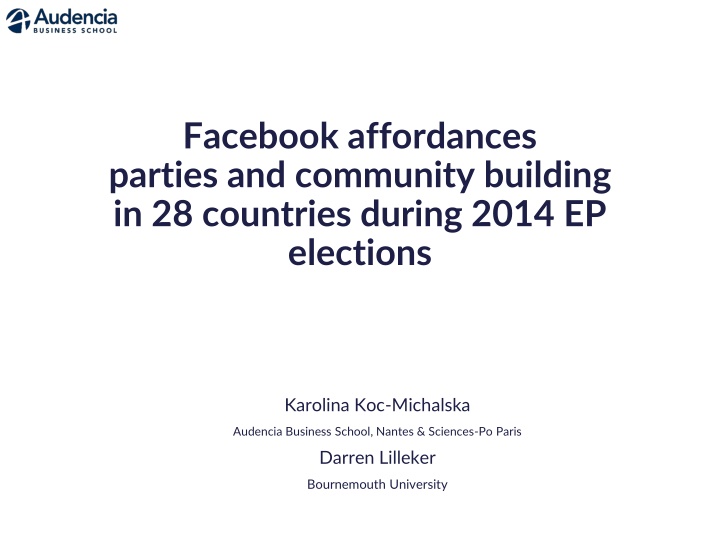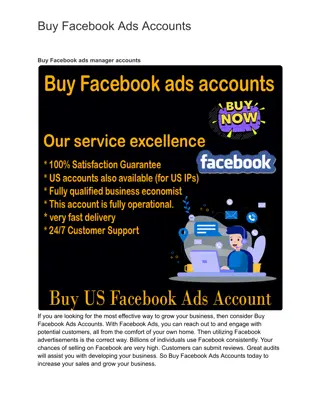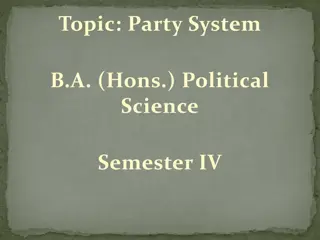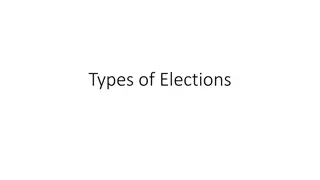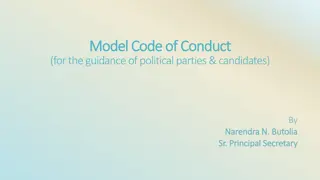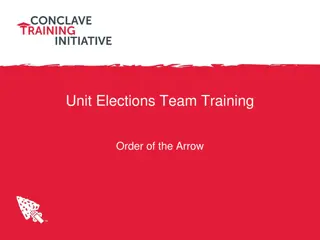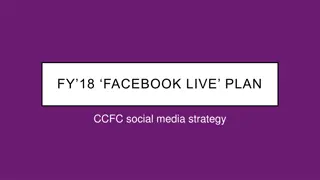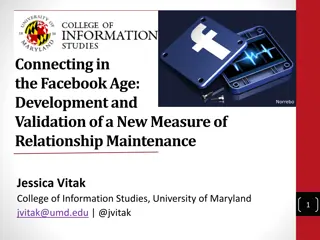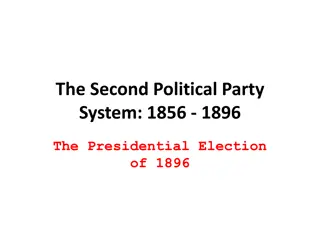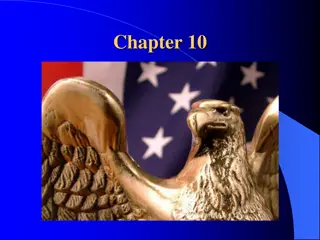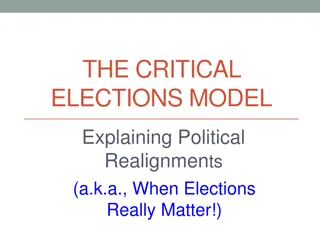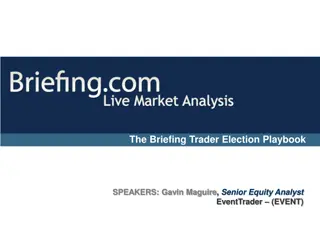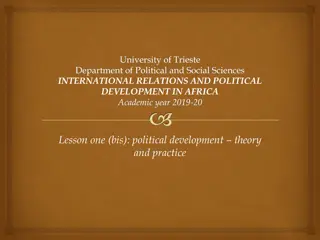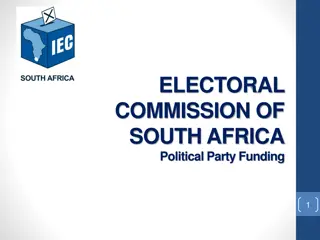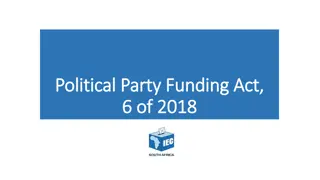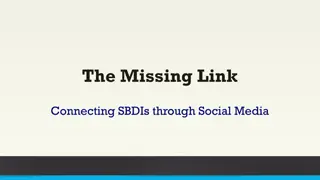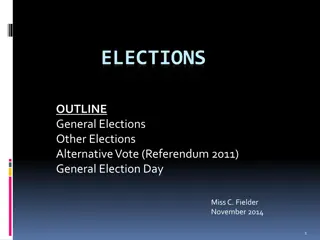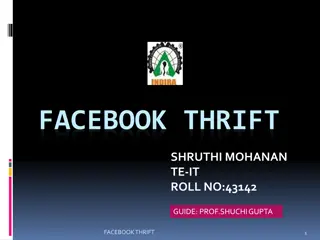Analysis of Facebook Affordances for Political Parties During the 2014 EU Elections
Research by Karolina Koc-Michalska and Darren Lilleker explores how political parties across 28 countries utilized Facebook affordances during the 2014 European Parliament elections. The study investigates the impact of social media on voter behavior, community building, and political engagement. Findings suggest that increased interactivity and engagement on social media platforms could influence voter support and attract diverse communities. The methodology involved analyzing data from 350 parties in 28 EU countries, with a focus on understanding the role of Facebook in community building and political communication strategies. Insights highlight the potential of Facebook in facilitating activities by community members and attracting different types of communities.
Download Presentation

Please find below an Image/Link to download the presentation.
The content on the website is provided AS IS for your information and personal use only. It may not be sold, licensed, or shared on other websites without obtaining consent from the author.If you encounter any issues during the download, it is possible that the publisher has removed the file from their server.
You are allowed to download the files provided on this website for personal or commercial use, subject to the condition that they are used lawfully. All files are the property of their respective owners.
The content on the website is provided AS IS for your information and personal use only. It may not be sold, licensed, or shared on other websites without obtaining consent from the author.
E N D
Presentation Transcript
Facebook affordances parties and community building in 28 countries during 2014 EP elections Karolina Koc-Michalska Audencia Business School, Nantes & Sciences-Po Paris Darren Lilleker Bournemouth University
Theoretical background greater numbers of members and interactions within a group lead to increased interest and support [Bortree & Seltzer, 2009] >> social media activities may influence the propensity to vote for certain candidates during 2016 US Presidential election [Groshek&Koc-Michalska 2017] >> social media political activity attract to politics possibly other groups (in France: young, disappointed with democracy, otherwise not politicized) [Koc-Michalska, Gibson, Vedel 2014] parties apply mainly broadcast messages [Jackson & Lilleker, 2009] and controlled interactivity [Stromer-Galley, 2000] >> Web2.0 interactive feature using have more important impact on vote gain than Web1.0 top-down communication flow [Koc-Michalska & Lilleker 2016] environmental affordances [Gibson 2015] what environment affords animal affordances: posses values and meanings are external to the perceiver perceiver depends on them BUT may influence their usage affordances within social media environment [Bucher and Helmond 2017] what media technology allow to do human creation of affordances > a design allowing others for actions
Research questions How Facebook affordance were used by political parties during EP2014 in order to: >> attract new communities? >> attract different types of communities? >> facilitate activities by community members?
Methodology 28 EU countries 2 weeks before 2014 European Parliament elections 350 parties > 291 with social media profile 73% with Facebook and Twitter profiles 3% only Twitter account 23% only on Facebook Two-level data: aggregated (party level) & disaggregated (post level) Sotrender: archiving tool
Potential of the community building FB 14 Average community potential use by party ~5% Table 5. Politically oriented Facebook community in the EU Political fans '14 Facebook users '14 Austria 200 177 Belgium 196 451 Bulgaria 59 032 Croatia 49 369 Cyprus 59 854 Czech 399 734 Denmark 145 925 Estonia 17 030 Finland 55 672 France 402 044 Germany 801 353 Greece 149 859 Hungary 525 463 Ireland 64 561 Source: http://www.internetworldstats.com/stats9.htm Facebook data for Dec 2014 ratio .069 .040 .023 .031 .103 .104 .048 .034 .024 .016 .032 .039 .123 .030 Political fans '14 Facebook users '14 846 181 1 731 32 711 18 391 47 739 182 390 381 727 182 411 115 036 85 273 24 245 446 752 325 735 860 723 ratio .036 .004 .029 .081 .220 .024 .039 .039 .021 .042 .033 .025 .066 .026 2 915 240 4 922 260 2 522 120 1 595 760 582 600 3 834 620 3 037 700 501 680 2 287 960 25 624 760 25 332 440 3 845 820 4 265 960 2 183 760 Italy Latvia Lithuania Luxembu Malta Netherla Poland Portugal Romania Slovakia Slovenia Spain Sweden United 23 202 640 414 520 1 118 500 227 520 217 040 7 554 940 9 863 380 4 663 060 5 374 980 2 032 200 730 160 17 590 500 4 950 160 32 950 400
How Facebook affordance were used by political parties during EP2014 in order to: >> attract new communities?
Facebook community growth 2 weeks of campaign
Facebook community growth Average community growth ~8.5% 50 40 30 20 10 0 Podemos (ES) Kongres Nowej Prawicy (PL) 47ths 41ths UKIP (UK) Die PARTEI Matteo Salvini (IT)23ths 36ths 25ths
Facebook community growth Coef. OR SM entry video link text photo 1.005** Active publication Video posts >> virality .032** .003 .008 .001 non of other variables made difference Party size (comp. Minor fringe) Major Parliamentary Minor Parliamentary Major Fringe Party years of existence .54 .319 -.957 .006 1.88 1.463 .387 1.006 Party ideology Left leaning Right leaning Pro-EU Governmental party FB/TW fans t1 .346 .027 .302 -.590** .00004** 1.452 1.078 1.304 .538** .999** Parties in opposition Country fixed effects and interactions are omitted from the output
How Facebook affordance were used by political parties during EP2014 in order to: >> attract different types of communities?
FB affordances => Community members ONE-TIME SUPPORTERS LOYAL LIKERS - like once (low activity) - like frequently but perform no other actions (medium activity) LOYAL SUPPORTERS - comment, like or share moderately (medium interactivity) HYPER-ACTIVE SUPPORTERS - comment, like and share intensively (high interactivity) DEBATING VISITORS - comment without liking or sharing (high interactivity which may include opponents)
Community members 6%2% 7% 31% 54% Debating visitors Loyal likers Hyper-active supporters One-time supporters Loyal supporters
Community members supporters Clictivists Loyal activists Debaters Post type Status Photo Video 1.018 1.014 1.015 1.011* 1.029** 1.008 1.008 1.041** 1.029* Party Characteristics Major Parliament Party Minor Parliament Party Major Fringe Party Party years of existence Left id Right Id Pro-European Governmental parties Community size t1 6.336*** 3.513** 12.003*** 3.524** 4.84** 2.667** .945 1.051 .533 .999 1 .999 1.491* 1.417 1.437 1.647* 1.495** 1.363 1.47 1.27 1.187 .942 .986 .887 1.001** 1.001** 1.001** Note: GLM negative binomial with the IRR as indicator for coefficient; * p<0.10, ** p<0.05, *** p<0.01; Country fixed effects and interactions are omitted from the output
How Facebook affordance were used by political parties during EP2014 in order to: >> facilitate activities by community members?
FB affordances for community activity LINK VIDEO STATUS PHOTO Communication 800 600 17863 posts 400 200 facilitated: 0 Comments Shares Likes 120 900 Shares and Comments ths. Likes ths. 800 100 700 80 600 500 5 036 916 likes 1 083 657 shares 546 754 comments 60 400 40 300 200 20 100 0 0
FB affordances for community activity Likes Shares Comments Owner responsiveness .372 *** .596 *** 1.041 *** Thread characteristics (ref. hyperlinks) Photo Status Video Length of the thread (ln) Photo*Length of thread (ln) Status*Length of thread (ln) Video*Length of thread (ln) .834 -.914 .133 .035 -.075 .125 .003 *** ** .666 -2.888 .647 .143 -.010 .387 -.008 ** *** *** *** .306 -1.158 .061 .072 -.010 .185 .016 *** ** ** *** ** *** *** ** Historical community Likes for last post (ln) Shares for last post (ln) Comments for last post (ln) .109 -.015 -.001 *** .022 .039 .026 .006 -.016 .100 ** *** Time specificity Day of campaign Time since last post (ln) Time till next post (ln) Nb. of posts within 1 hour Weekend Campaign silence 48h Campaign silence 24h .026 .592 .449 -.062 .025 -.104 -.168 *** *** *** *** .029 .719 .283 -.069 -.072 -.322 -.267 *** *** ** *** .025 .581 .426 -.085 -.067 -.231 .124 *** *** *** *** *** ** ** hours, time slots, party fixed effects are omitted from the output
FB affordances for community activity Likes Shares Comments Owner responsiveness Thread characteristics (ref. hyperlinks) Photo Status Video Length of the thread Photo*Length of thread Status*Length of thread Video*Length of thread .372 *** .596 *** 1.041 *** .834 *** -.914 ** .666 ** -2.888 *** .647 *** .143 *** .306 *** -1.158 ** .133 .061 .035 ** -.075 *** .125 ** .072 *** -.010 .387 *** -.010 .185 ** .003 -.008 .016 hours, time slots, party fixed effects are omitted from the output
FB affordances for community activity Likes Shares Comments Owner responsiveness .372 *** .596 *** 1.041 *** Thread characteristics (ref. hyperlinks) Photo .834 *** .666 ** .306 *** Status -.914 ** -2.888 *** -1.158 ** Video .133 .647 *** .061 Length of the thread (ln) .035 ** .143 *** .072 *** Photo*Length of thread (ln) -.075 *** -.010 -.010 Status*Length of thread (ln) .125 ** .387 *** .185 ** Video*Length of thread (ln) .003 -.008 .016 Historical community Likes for last post Shares for last post Comments for last post .109 *** -.015 -.001 .022 .039 ** .026 .006 -.016 .100 *** Time specificity Day of campaign Time since last post (ln) Time till next post (ln) Nb. of posts within 1 hour Weekend Campaign silence 48h Campaign silence 24h .026 .592 .449 -.062 *** *** *** *** .029 .719 .283 -.069 *** *** ** *** .025 .581 .426 -.085 *** *** *** *** .025 -.072 -.322 -.267 -.067 *** ** -.104 -.168 -.231 ** .124 hours, time slots, party fixed effects are omitted from the output
FB affordances for community activity Likes Shares Comments Owner responsiveness .372 *** .596 *** 1.041 *** Thread characteristics (ref. hyperlinks) Photo .834 *** .666 ** .306 *** Status -.914 ** -2.888 *** -1.158 ** Video .133 .647 *** .061 Length of the thread (ln) .035 ** .143 *** .072 *** Photo*Length of thread (ln) -.075 *** -.010 -.010 Status*Length of thread (ln) .125 ** .387 *** .185 ** Video*Length of thread (ln) .003 -.008 .016 Historical community Likes for last post (ln) .109 *** .022 .006 Shares for last post (ln) -.015 .039 ** -.016 Comments for last post (ln) -.001 .026 .100 *** Time specificity Day of campaign Time since last post (ln) Time till next post (ln) Nb. of posts within 1 hour Weekend Campaign silence 48h Campaign silence 24h .026 *** .592 *** .449 *** -.062 *** .029 *** .719 *** .283 ** -.069 *** .025 *** .581 *** .426 *** -.085 *** .025 -.072 -.067 -.322 *** -.267 ** -.104 -.231 -.168 ** .124 hours, time slots, party fixed effects are omitted from the output
CONCLUSIONS FB affordances to build communities The potential of the Facebook users per country is not highly used by political parties => is there a real interest in attracting communities? controlled interactivity During the electoral time there is a potential to attract new community members => being in opposition helps, but no other characteristics matter same chances => Role of viral marketing (videos) => stagnation during non-electoral times? Different communities around parties => 85% of political party s community Clictivists => 16% highly engaged people => positive vs. commenting (trolls) => Left-wing parties - attract Clicktivists => Right-wing parties / pro-EU party - attract the Debating community => Size of the party and size of the community before election matter
CONCLUSIONS FB affordance to build communities Interaction with the community Posting photo or video (for virality) => video fuel the community growth and activity Posting status text should be elaborated, not graffiti style => elaborated text entries encourage activities from the community Probable clustering of fans likers > likers, commenting > commenting, sharing > sharing Importance of consistent publishing during the whole campaign period, BUT communities get more engaged closer to election date Time of posting matter => Constant posting ruins the activity of the community Maximizing the community activity => To get LIKES: 2 posts per day at 6-7 am and 6-7 pm => To get SHARES: 1 post per day at 6-7 am => To get COMMENTS: 1 post every two days
Thank you kkocmichalska@audencia.com
